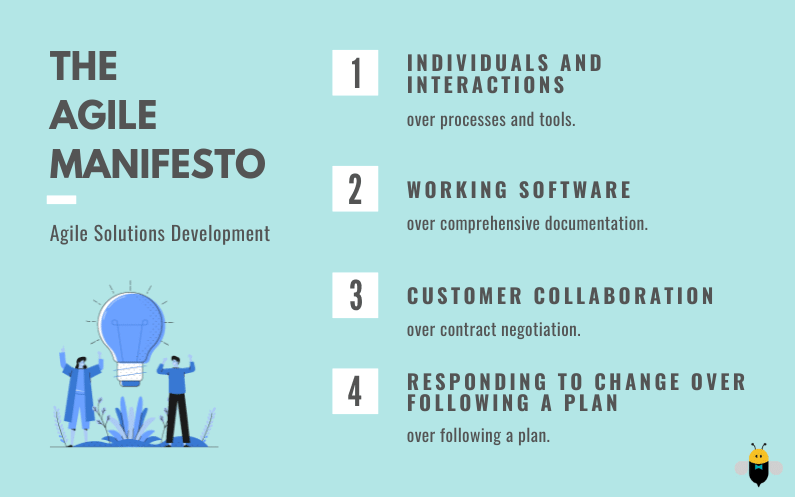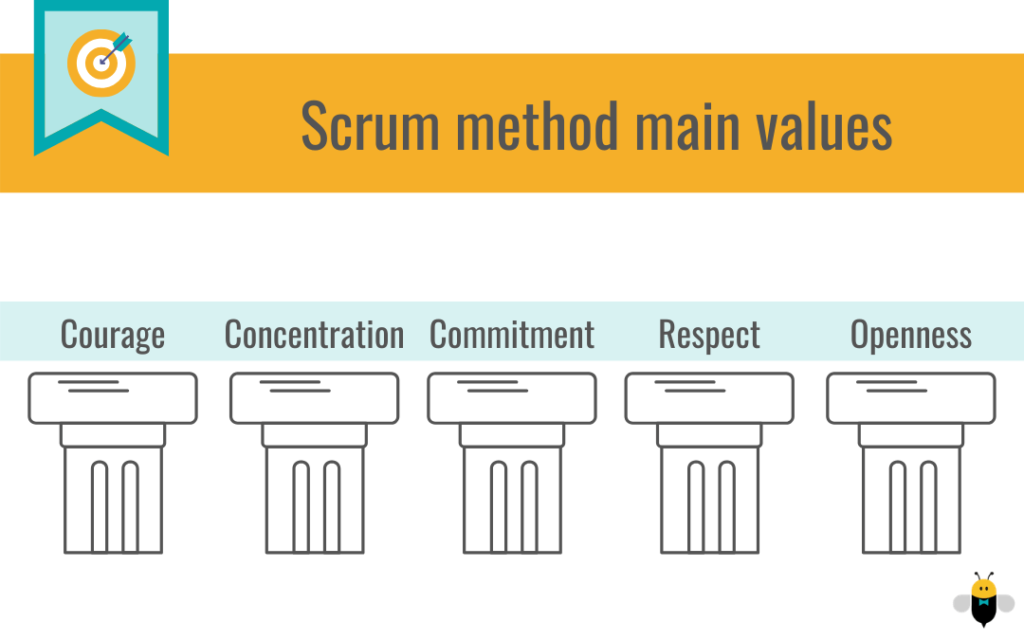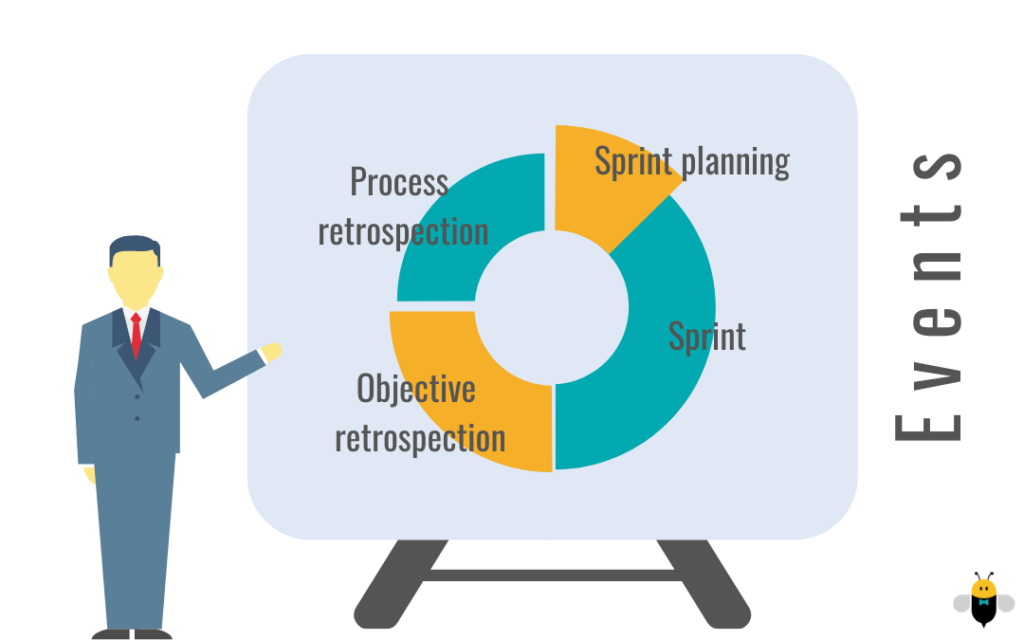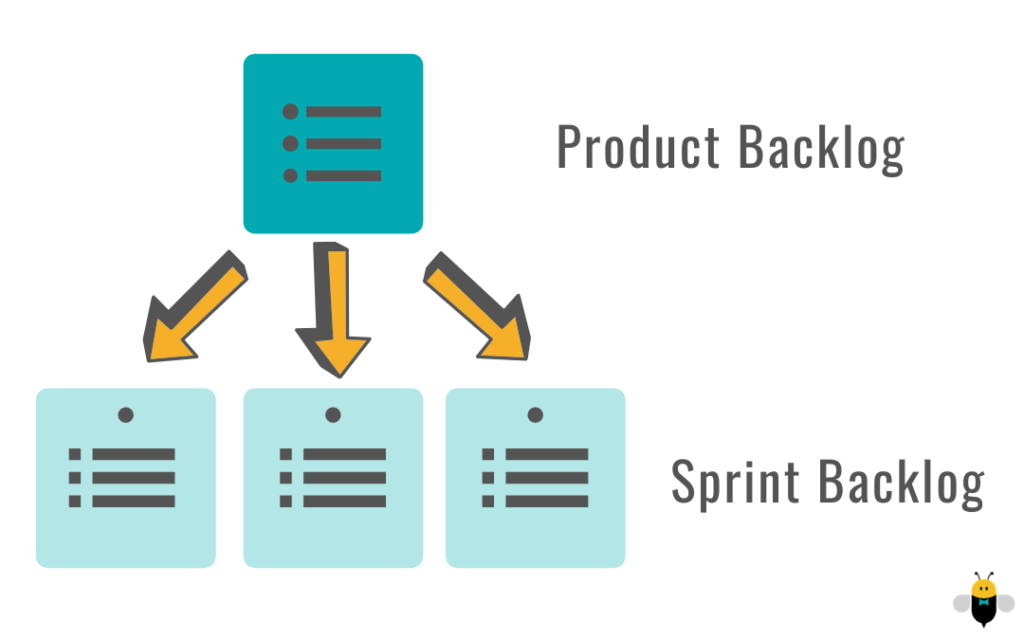You may have heard of meetings in your workplace called “scrum”? Scrums are much more than meetings! The name given to these meetings is actually “daily scrum”. It is one of the structures integrated into the scrum method (therefore much broader than meetings) which itself comes from agile project management.
What is all this? It is a group of work methodologies originally applied to software development. But, because of its versatility and adaptability, it is applicable to many fields today!
By adopting an agile work method, such as scrum, you could be more productive, while increasing cohesion within your team. Interested in learning more? Read on to learn more about the scrum method and how to apply it in your company!
You will find in this article:
- Agile project management
- Origin: The Agile Manifesto
- Multiple working methodologies
- Scrum: presentation of the method
- 5 main values of the scrum method
- Events – Milestone in a work cycle
- Roles
- Company agility
Agile project management
Let’s start by looking at agile project management together. It is a set of practices and methods inspired by the values and principles of the Agile Manifesto. The principles of collaboration, autonomy and interdisciplinary teamwork are the key: let’s avoid working in silos!
Origin: The Agile Manifesto
Agile project management is based on 4 elements. These are presented in the image below.

From these 4 elements emerge 12 principles fundamental to agile management. The different working methodologies are all based on these 4 key elements and these 12 principles. Agile thinking is built around them.
Multiple working methodologies
The agile method brings together several methodologies and each one meets different needs. The most popular ones are certainly:
- eXtreme Programming (XP);
- Scrum;
- Feature Driven Development (FDD);
- Lean Software Development;
- Agile Unified Process (Agile UP or AUP);
- Crystal;
- Dynamic Systems Development Method (DSDM).
In this article, we will focus on the scrum method. Other methods will not be discussed.
Scrum: presentation of the method
The name scrum was not chosen by accident. It comes from rugby. What’s the connection? It’s a metaphor for a game strategy that means adapting and changing the direction of the project at the same pace as it progresses. In other words, the scrum encourages work teams to learn from their experiences, organize themselves and collectively reflect on possible improvements.
5 main values of the scrum method
In order to better understand the scrum method, let’s start by evoking the 5 main values. Values are inseparable from agile logic.

First, courage. When an individual evolves in an agile management environment, it is imperative that he or she demonstrate courage. Here we hear the simplest form of courage: talk. Don’t be afraid to speak up about your point of view and your ideas, even if they seem silly to you. Collaboration is essential, so remaining silent does not allow you to move forward properly.
Then concentration. When working with the scrum method, a team works in Sprint (work cycle – we discuss this in the section below), so you need to stay focused on the tasks to be accomplished during this cycle. It is easy to get lost and scatter on other tasks, especially when working on a large project. The motto is simple: FOCUS. Concentrate on your task and on the objective to be achieved during this Sprint.
Next, commitment. You must respect what has been agreed to. The whole team must work towards the common goal determined in advance.
And respect. Isn’t that the basis of all healthy relationships? Respect your co-workers. Everyone is courageous enough in expressing their vision, views and ideas. Failure is not failure. It is a learning opportunity. It is also about respecting the time allowed for each step in your process.
Finally, openness. Be open to the ideas of others, adapt the process after each Sprint and make the project evolve according to the direction it takes.
Events – Milestones in a work cycle
This agile project management methodology encourages working in cycles. What do we mean by this? It means that a project will not be seen in its totality over a long period of time. Instead, the project will be broken down into different stages of creation and production:
- Sprint planning;
- Sprint;
- Objective retrospection;
- Process retrospection.

Sprint Planning
Sprint planning is the first step. It is during this meeting that the Product Owner (the roles are presented below) will present to the development team and the Scrum Master the Product Backlog, a comprehensive list of tasks to be done in order to complete the creation of the product. The Beenote solution will be able to help and support you through this step. From preparing the meeting agenda to distributing invitations, every step is simplified with Beenote.
During the meeting, a task to be performed will be selected according to a logical process. Then, the development team will identify all the sub-tasks they can accomplish during this Sprint. These will compose the Sprint Backlog, the task list associated with a particular Sprint.

The time dedicated to this meeting is calculated by a simple equation: 1 week of sprint for 1 hour of meeting. So, if your sprint is spread over 1 month (4 weeks), the meeting should last 4 hours.
The Sprint
The Sprint represents the period of time during which the development team will work on the tasks of the Sprint Backlog. Generally, a Sprint has a length of one month.
Daily Scrum
It is during this month that the “scrums”, as they are often called, will take place. Daily scrums or daily standups are daily meetings of about 15 minutes, usually in the morning. Conducting these meetings standing up avoids stretching the time and exceeding the time scheduled.
And, why not take the opportunity to go for a walking meeting? The health benefits of walking are well established! Furthermore, an application like Beenote will assist you in your meetings, even if they are on the move!
Their purpose is to inform all team members, the Scrum Master and the Product Owner about what is happening, and about the evolution of the tasks. It is an informative meeting. In turn, each person will answer 3 questions:
- What did I accomplish yesterday?
- What will I work on today?
- What are the difficulties experienced?
Do you have team members working remotely? No problem! They can also be present at daily meetings with the help of videoconferencing. Combine your videoconferencing tool with Beenote to be able to easily exchange information while being able to follow the progress of the meeting by consulting the agenda simultaneously.

Objective retrospection
This stage takes place at the end of a Sprint. Everyone comes together and it is at this point that a review of the accomplished task is made. The achievements are presented in turn, which allows a retrospection. All the work done in order to achieve the desired quality should be demonstrated.
This meeting should last between 30 and 60 minutes. The format of the meeting is at your discretion depending on the personality of your work team. Informal so that this event is more considered a celebration or formal, like a classic meeting.
Process Retrospection
Process retrospection is the last step in a cycle and is a reflection on the process itself. It is not about talking about the product or the tasks accomplished, but about how the team worked. It’s a time to take stock of what worked well and what needs improvement. 60 minutes should be enough time for this meeting.
Roles
In the last few paragraphs, we mentioned roles represented by individuals, such as Product Owner and Scrum Master. But, who exactly are they and what are their roles? Let’s sort this out!
Product Owner
The Product Owner is the defender of the product. He represents the link between the market and the customers to the development team. It is also his role to establish the Product Backlog and manage it. He also prioritizes the order of tasks to be performed.
Scrum Master
The Scrum Master is the guardian of the process. He has an advisory role with the development team both in terms of the smooth running of the process and good collaboration. He supports motivation and, if necessary, acts as a mediator.
Members of the development team
The development team, as the name implies, is responsible for development. It is usually composed of 5 to 7 people from different fields. The scrum method encourages multidisciplinary teams. Team members self-organize, work closely together and are responsible for establishing the Sprint Backlog.
Company agility
Now that you know all the theories and the main principles, one question remains. It’s all well and good, but how can we apply it in companies? We propose a step-by-step procedure that will allow you and your team to become familiar with the method. Start with a small project. Because you have to learn how to walk before you run!
1. Introduce the method
Start by introducing the scrum method to your team. Make sure everyone is well informed and onboard.
Tip: Show this short video to your team. The method is clearly explained. In only 10 minutes, the basics will be learned! Discover scrum in 5 minutes with Organize Agile>.
2. Distribute roles
Who will be the Product Owner? Who will be the Scrum Master? And, who will be the members of the development team? Make sure that everyone understands their role, but also everyone else’s role.
3. Create the Product Backlog
As mentioned above, the creation of the Product Backlog is the responsibility of the Product Owner. It is the person in this role who will develop the complete list of tasks.
4. Plan the sprint and create the Sprint Backlog
The Sprint will have to be planned beforehand, it is an essential but preliminary stage. Then, it will be the turn of the development team to get into action. It will establish the Sprint Backlog before starting the Sprint.
5. Sprint and daily scrum
Once the Sprint is launched, the creation and development process begins. The development team will work on completing the tasks of the Sprint Backlog. Short daily meetings, the daily scrum, will allow everyone (Product Owner, Scrum Master and the development team) to be informed of the work done and the issues.
Tip: You can make these meetings more dynamic by encouraging participants to pass a balll that will act as a ” speaking stick “.
6. Objective retrospection
Once the Sprint is complete, schedule a meeting in which everyone will present what they have advanced or accomplished on product creation only. Invite people to explain what worked well and what did not.
7. Process retrospection
A second meeting is in order. Unlike the first one, it is in this one that people will be able to discuss all the elements that worked well or not in relation to the process. Work collectively to find ways to improve and thus work better as a team.
Remember that it is not a question of including agile principles to make a team agile. It is a process that requires time and adjustments. Unlike the creation and production cycle, integrating the scrum method is not a sprint, but a marathon!









0 Comments